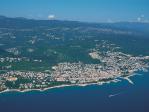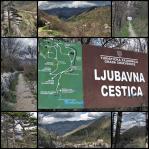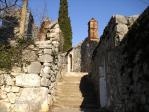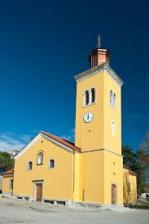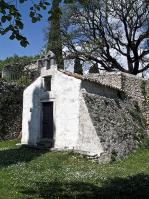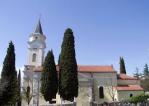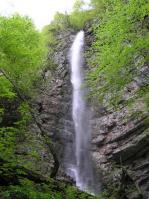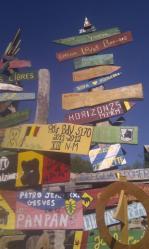The history of Crikvenica dates back to ancient times ... Under the ancient name of Ad Turres, Crikvenica is mentioned as one of the key locations along the Roman road from Italy to Dalmatia. Migration of the Visigoths after the 400th forced the local population to seek protection on the hilltops. The people of Ad Turres found refuge within the walls of the prehistoric fortress KOTOR. End of war devastation has enabled resettlement coast. On the left side of the mouth of the river Dubra─Źine is built a small church dedicated to the Blessed Virgin Mary. Beside it , Prince Nikola IV Frankopan raises 1412th ┬ábig building and gives it to ┬áPaulist monks. This monastery building marked the beginning of the creation of Crikvenica, and Prince Nicholas Frankopana can be regarded as its founder, the Blessed Virgin Mary is considered to be its patron.
Love trail
Keywords: trekk, walking
Region: Riviera Crikvenica - Vinodol
Nearest town: Rijeka
Content: Nature
Name of Love trail probably originated in thirties of the last century, refering to frequent arrivals of romantic couples in this romantic place.
Love trail unites several particle content - walking through the shade of pine trees and aromatic Mediterranean herbs, visiting Romanesque fortress (in ruiners) Badanj with beautful view at Vinodolska valley, Kvarner and Velebit Channel.
Love trail opens city of Crikvenica towards the immediate hinterland - green Vinodolu, full of cultural and historical monuments.
Old settlement Kotor
Keywords: old settlement, tower, architecture
Nearest town: Rijeka
Content: Architecture
Old settlement Kotor
The old Crikvenica is a settlement of Kotor, located at the top of the nearby hill named. The oldest material traces of human life has left its indigenous inhabitants, and the Romans named it Ad turres, which the Croats after populating this area translated as tor (at the tower) .
It was a large village with a church and five smaller churches. In 1776, fire destroyed the mighty Kotor. The pastor of the church and the values ÔÇőÔÇőfound shelter in the Paulist monastery in Crikvenica. The largest part of the population the moved closer to the sea, and after a fire in Kotor returned only a few families. Today it is in ruins and abandoned.
Church of the Assumption of the Blessed Virgin Mary
Church of the Assumption of the Blessed Virgin Mary is the oldest preserved church in Crikvenica and, with the former Pauline monastery nearby, represents an old town centre. Nikola  the IV-th  Frankopan ordered it to be bulit in 1412. The church also contains many valuable paintings and sculptures, among which stands out the picture of St . Simon, the only surviving item from the old Parish Church of St. . Simon and Jude Thaddaeus, which was destroyed by fire on Kotor in the 18th century.
Other churches to see:
The Russian Orthodox Church was built in 1924 on the initiative of Russians who had fled to Crikvenica after the October Revolution. The church is dedicated to St. Nicholas and was constructed in the typical style of Russian church architecture. It has been closed for many years
The Church of St. Anthony of Padua
The foundation stone for this church was laid in 1934. The church was consecrated in 1939, but the impressive 35 m-high belfry was only finished in the first decade of the 21st century.
Selce, Jadranovo and Dramalj
Content: Sacral monuments and leftovers
DRAMALJ
The church of St. Helen was built on the spot of an old chapel, which had been converted in the Baroque style and expanded in the 18th century, when Dramalj was a chaplaincy of the parish of Belgrad. In 1796, a famous artist from Rijeka, Giuseppe Capovilla, made a marble altar for this church. The Parish of St. Helen was founded in 1809, but the Parish House and the Church of St. Helen were only built after 1812. Mate Balas, the parish priest at that time, used his own money and the contributions of his parishioners to initiate construction of the new church. The interior of the church was decorated in the 19th century: the pulpit in 1837, and the main altar in 1845. In the immediate vicinity of the church is the House of Culture, which was built from 1925 to 1928 and hosted the first people's library (founded in 1939).
JADRANOVO
The oldest cultural monument here is the archaeological site of Lokvišće from the Roman era, which has the remnants of several ancient buildings. Apart from this archaeological site, the cove of Lokvišće is noted for the balneological qualities of its natural medicinal mud.
The Church of St. James the Apostle was built in the first decade of the 19th century. Based on available documents and the overall appearance of the church, it can be assumed that it was built in several phases. The chapel of St. James the Hermit was constructed first. The nave of the church was added in 1812 due to the effort of Father Mate Balas. The Parish of ┼áiljevica was established in 1806 on the initiative of Bishop Je┼żi─ç of Senj and Modru┼í.
The Church of St. James was built of stone in the Romanesque style. It is oriented in the east-west direction, with the main altar on the east, and fa├žade towards west. The wooden statue of St. James, patron saint of the village, is more than 350 years old and is placed on the main altar. Apart from this statue, there are also the statues of Saints Fabian and Sebastian and Saints Peter and Paul in the middle of the altar. Several votive chapels have also been added over the years by local people in gratitude for various occasions.
The old tuna lookout post symbolises the local tradition of fishing and is one of the few such posts that have remained preserved throughout the Kvarner region.
SELCE
Parish Church of St. Catherine
This church was built in 1888. The main marble altar is the work of the famous master from Rijeka, Pietro Rizzi. The painter Giovanni Fumi, of Venetian origin, created the painting of St. Catherine, located above the tabernacle. The ceiling in the sanctuary was painted in 1910 by Ferdinand Ludwig from Senj. The organ and the baroque stone baptistery, which is now located beneath the choir, were transferred here from the old church. This church also holds a baroque reliquary of St. Catherine.
Chapel of St. Catherine
This little church, located in a small, secluded park, is thought to date back to the pre-Romanesque period. In the 15th century it was already rather dilapidated. After
Chapel of St. Joseph
This was originally the sanctuary of the baroque single-nave church of St. Catherine. The church altar, the former main altar of the baroque church of St. Catherine, was made by Jacopo Businello and Antonio Capovilla. Their work was influenced by the Venetian masters who had built several baroque gold altars in this area.
Chapel of Saint Fabian and Saint Sebastian
Located outside the village, near the crossing of the main coastal road and the road to Bribir, this chapel is dedicated to the two patron saints offering protection from plague and cholera. It was built in the mid-19th century in a historicist, neo-baroque style.
Chapel of St. George
It is assumed that the oldest part of this church was built in the pre-Romanesque period (9th-11th centuries AD) on the spot of a Late Antiquity military guardhouse. It is dedicated to St. George, the most popular medieval saint, who is often connected to the pre-Christian pagan tradition of Green George, which symbolises the arrival of spring.
Interesting routes
To residents of the area, Nature Park Škarline is an inseparable part of local identity and holds an indelible place in the collective mind. Visitors to the area sometimes fail to discover this perfe...
The entire Vinodol is a beautiful story, composed of rich history, numerous cultural and historical monuments, natural resources and tradition. It is one thing to experience Vinodol by passing through...
Devil's passage, Green vortex and caves Mu┼żeva ku─ça, even as far back as 1962, were declared a special geomorphological reservation with area of about 200 ha. Today the area of ÔÇőÔÇőthe Green vorte...
The Velebit shelter for bear cubs
Velebit association Kuterevo was founded in 1995 with the aim of preserving the wild life of Croatian highlands.
In year 2002, Velebit association Kuterevo and the Cr...
